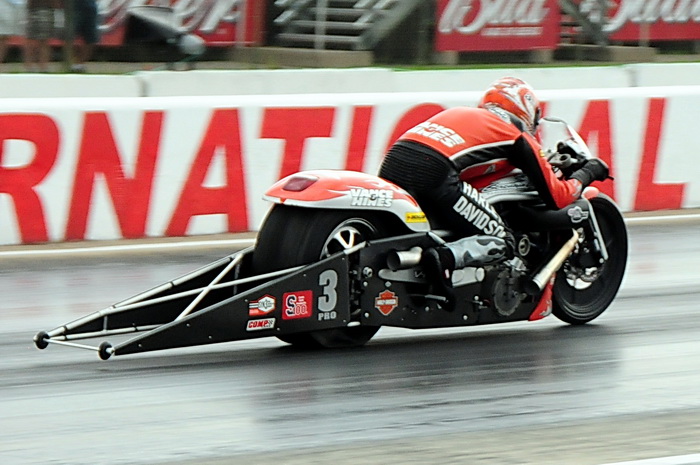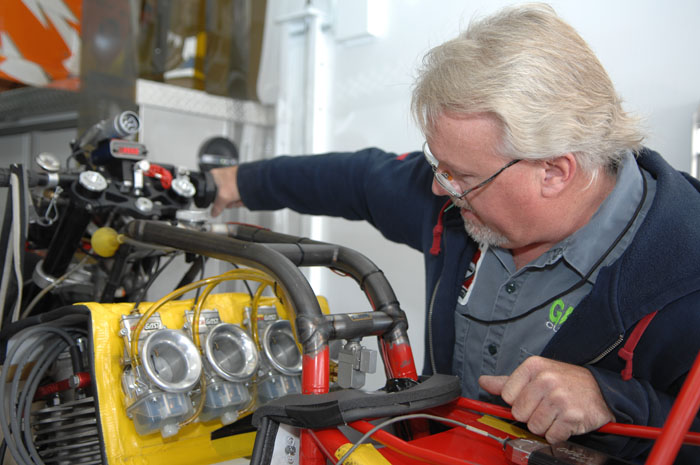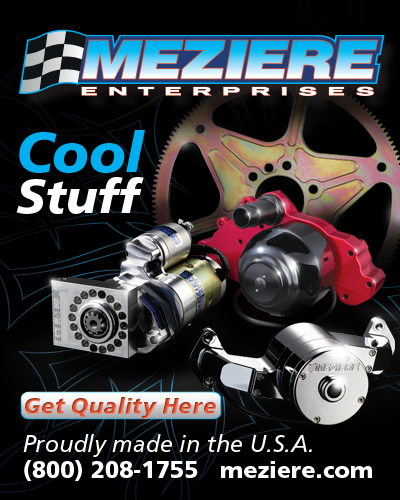PSM RIDERS FEAR CLASS PARITY OFF AGAIN
There’s no question, Harley-Davidson is setting the pace in NHRA’s Pro Stock Motorcycle class.
Andrew Hines is atop the point chase on his Screamin’ Eagle Vance & Hines Harley-Davidson, and he is fresh off setting a new national elapsed time record of 6.815-seconds at the U.S. Nationals.
Blake Gann, owner and crew chief for his son Shawn Gann, who competes in the Pro Stock Motorcycle ranks on a Buell, believes Hines and his teammate Eddie Krawiec have an unfair edge over their competitors. Krawiec is fourth in the points while Gann is 12th.
“It is hard to say what the state of the NHRA’s Pro Stock Motorcycle class is right now,” Blake Gann said. “Of course, Harley-Davidson is the official motorcycle of the NHRA. The Vance & Hines team runs Harley and they have a big advantage on the rules, basically they do not have a rulebook. Everybody who is racing, whether they’re racing Suzukis or Buells, we basically have to face the fact that Harley bought the series. They hold the receipt for it and they’re going to win. It’s a very uneven playing field, but we have nowhere else to play. We have all this money in motorcycles and engines and if they (NHRA) do not run motorcycles, what are we going to do with them? We do not have anywhere else to race. We basically just swallow and say we understand the V-Rods are going to win, but we still race.”
There’s no question, Harley-Davidson is setting the pace in NHRA’s Pro Stock Motorcycle class.

Blake Gann, owner and crew chief for his son Shawn Gann, who competes in the Pro Stock Motorcycle ranks on a Buell, believes Hines and his teammate Eddie Krawiec have an unfair edge over their competitors. Krawiec is fourth in the points while Gann is 12th.
“It is hard to say what the state of the NHRA’s Pro Stock Motorcycle class is right now,” Blake Gann said. “Of course, Harley-Davidson is the official motorcycle of the NHRA. The Vance & Hines team runs Harley and they have a big advantage on the rules, basically they do not have a rulebook. Everybody who is racing, whether they’re racing Suzukis or Buells, we basically have to face the fact that Harley bought the series. They hold the receipt for it and they’re going to win. It’s a very uneven playing field, but we have nowhere else to play. We have all this money in motorcycles and engines and if they (NHRA) do not run motorcycles, what are we going to do with them? We do not have anywhere else to race. We basically just swallow and say we understand the V-Rods are going to win, but we still race.”
Glen Gray, NHRA’s vice president, technical operations, disagrees with Blake Gann.
“I do not agree that Harley-Davidson writes its own rulebook,” Gray said. “We have a parity-based system. We made changes this year. We gave Suzuki six cubic inches at the beginning of the season and that brought parity amongst the three manufacturers. For most of the season, the riders were pretty much neck-and-neck.”
Of the 12 Pro Stock Motorcycle events so far this season, Hines has won five times and Krawiec once. Michael Phillips, aboard the Pistonator Suzuki, has three wins and Matt Smith has piloted the Al-Anabi Buell to two victories. LE Tonglet also won on the U.S. Nationals on a Suzuki.
Gray said the current motor the Harley-Davidsons are utilizing took several years to approve.
“That process (to approve that engine) started four and half years ago because that engine is almost two years old now,” Gray said. “That was a whole new engine, so that was a different thing. If it is a (cylinder) head or something like that, it isn’t going to take four and half years.”
Gray says the NHRA tries to maintain parity in the Pro Stock Motorcycle class by analyzing what the bikes do after each national event.
“We look at the fastest elapsed time and then we look at the average of the four fastest elapsed times,” Gray said. “Really, going into a couple of races before the Countdown, Harley was actually lagging a little bit in that area.”
NHRA made its most recent rule revision for Pro Stock Motorcycles on Sept. 10.
“We took 10 pounds off the Buells to bring them more in line with the performance of the Suzukis and the Harleys,” Gray said. “Over the last three races, the Suzukis and Harleys were out performing the Buells. We have a system in place where any manufacturer that has an average of its four quickest times (at an event) that is five-hundredths of a second faster than any of the other manufacturers, that starts the review process. We can immediately, if it is really bad, make a change before the next race. Or we can wait a race and look and see if it will sort itself out at the very next race. You don’t want to be changing things every race.”
Based on what the NHRA saw at the last three races, since Denver, the sanctioning body revised some rules.

Gray says the Pro Stock Motorcycles do not have a standard weight. The Suzukis are 595 pounds, Harleys are at 640 pounds and the Buells were at 625 pounds before Friday and they now will run at 615 pounds.
“That weight change for Buells will be for the remainder of the season, unless we have some other huge parity issue between now and the last five races of the year,” Gray said. “We would obviously hope not to make any more changes in the Countdown, but we do not ever rule that out in case there is something outlandish that happens.”
No matter how NHRA explains its Pro Stock Motorcycle parity system, Blake Gann isn’t buying what the sanctioning body is selling.
“It’s frustrating what Harley-Davidson gets to do and even the people who are leasing or buying Suzuki engines from Vance & Hines, they understand they are going to get outrun by the V-Rods,” Gann said. “The V-Rods just have a way better deal going on. They have four valves per cylinder and an overhead cam. We have a two-valve engine and a pushrod motor in our Buells and it is just so uneven. The Suzuki engines right now are 1755 cc’s, and they’re an in-line four-cylinder. Originally, they said for a V-twin to be competitive, they had to be at least 160 cubic inches, and that’s what we have in our Buell. Two years ago, I thought we were all on a pretty level playing field. Then, they (NHRA) gave Suzuki another 100 cc’s because mainly Buell doesn’t exist anymore. That company went out of business and Harley has dropped the Buell brand. Last year, the Suzukis were 1655 cc’s and now they’re 1755 cc’s and the Vance & Hines V-twins have overhead cams, four valves per cylinder and when it comes to our engine packag
e (with Buell) they (NHRA) give us nothing.”
Gann and his company, Gann Custom Speed, builds parts out of their shop in Stoneville, N.C.
“We build Suzuki engines and our biggest thing is we manufacture parts,” Gann said. “Almost the entire NHRA (Pro Stock Motorcycle) class runs our clutch. If there are 20 bikes at a race, 15 will have our clutch. We manufacture clutches, and cylinders, we make a lot of parts. What we do is take existing approved parts and modify them so they can be used in the NHRA. When we started racing the Buell, we had the Suzukis setting here and we had a lot of engines and we stumbled into the engine-leasing business. There are people who want to go race, but it’s a big expense to go to the NHRA and race. A lot of people can get the license, but they just can’t get enough money to get the bike and the engine. So, it makes more economical sense for someone to lease someone’s bike that is competitive. We have been leasing bikes and engines for two years now. We help a lot of people with Buell engines. Almost every team out there, except for Hector (Arana), we do work for.”
Blake Gann also is miffed why no other Pro Stock Motorcycle racer, except Andrew Hines and Krawiec, can utilize Harley-Davidson parts.
“Anybody that does a Suzuki cylinder head, for example, you have to have X amount of heads and parts available to the public,” Gann said. “Even though you do not have to have them make as much horsepower as what you’re running, you have to have that part available to your competitor. But, you can’t buy a V-Rod. The engines that are in their Screamin’ Eagles bikes are billet one-off engines made at their shop (in Brownsburg, Ind.). You can’t buy cylinder heads, you can’t buy a cylinder, and you can’t buy a set of engine cases. There’s not one piece of that motor bike that’s available to public or a competitor. Period. So, how is that fair?”
Why Harley-Davidson engines and parts aren’t available to other competitors, Gray didn’t have a definitive answer.
“I have been here (at NHRA) for two years, and I’m not copping out, but when I got here that was the process in place for Harley,” Gray said. “They were not available to everyone, they were only available to the Harley-Davidson (NHRA) team. That is the kind of thing we will be looking at in the off-season. I do not know where that is going to go at this point, but that needs to be addressed. We will look at a lot of different parity issues for the bikes in the off-season.”
According to Gann, in 2007 he developed a cylinder head for the Suzuki-powered NHRA Pro Stock Motorcycles.
“They (NHRA) approached us and this was at a time when the Suzukis were a little behind,” Blake said. “They (NHRA) said we hear you have the means to build a cylinder head and you want to and we’re approaching you to see if you want to continue that and we would go ahead and encourage you to do it and we will approve it if you do and it has more power. So, we developed a new cylinder head and it was a pretty cool deal.”
After completing the cylinder head a few years back, Gann then followed the protocol to get the part approved by NHRA.
“They told us to submit the papers at Indy that year and we did,” Gann said. “At (the second) Vegas race, they (NHRA) told us that they (NHRA) decided we only had to do 15 of them (cylinder heads for Suzukis). The rule used to be that you had to have 30 castings or parts on the shelf to meet their requirements, but that’s when Suzukis had the whole field. Of course now there’s three brands out there and sometimes four. They (NHRA) asked us if doing 15 cylinder heads was a problem and I told them it was not a problem. Then, they call me right before the PIR (Performance Racing Industry) show in Orlando, and said is it possible you can have one of those things (the Suzuki cylinder head) roughed out so we could take a look at it, so we can take picture of it and look at it. I said, no problem. Then, two weeks before the start of the Gatornationals, they (NHRA) called and said that (cylinder) head project is over, forget it. That was pretty devastating because the last time I had talked to them, I told Danny Gra
cia (NHRA’s National Technical Director), I said, 'look dude I’m going back to the house and I have to spend $40,000 (to continue this cylinder head project), so I really need to make sure this cylinder head is a go'. He (Gracia) said go back home and get to work on it. Then, two weeks before the Gators, I had engines ready and everything to run the (cylinder) head and they (NHRA) just pulled the plug on it.”
Once Gann made it the Gators, he claims the NHRA technical group had a change of heart.

“They said, we’ve decided we are going to let you do this deal, and can you have the engine done on the dyno and bring us a running engine to Atlanta,” Blake said. “I said sure. So I come home get the engines ready and jump through all the hoops again and get to Atlanta and he (Gracia) brings a letter over that said I’ve been denied. It was crazy. I already had orders for the cylinder head when I got to Atlanta. Wesley Wells had ordered one, Mike Berry had ordered one, Paul Gast had ordered one and everybody who ordered one was at that race in Atlanta. They couldn’t believe the deal didn’t go down and I have no idea why the NHRA denied me (for the cylinder heads). I have not tried to re-submit it (the Suzuki cylinder head) because every time I mention that I’m going to go over and talk to them (NHRA) about it, they roll their eyes and are like you can re-submit if you want to waste your time. No, I do not want to waste my time. I do not have time to waste.”
Gann did complete his Suzuki cylinder head project and the cylinder heads are in use, just not in the NHRA.
“I have sold several of the cylinder heads and several guys in the ADRL (American Drag Racing League) are using them,” Gann said. “Charlie Prophit is running my cylinder head, and we have several guys out there running them right now (in the ADRL), they’re just not where I intended them to be. I made 15 of those Suzuki cylinder heads and I spent a fortune doing it. We probably have $200,000 in the project.”
While Gray didn’t speak specifically to Gann’s case, he explained how the procedure should work with the NHRA.
“We wouldn’t go out to the manufacturers and ask them to do something,” Gray said. “The manufacturer would come to us and ask can we make this change to our engine or can we make this change to our bike? Then, it would go through a lengthy approval process. It has to come from the manufacturer though, it can’t come just from a team. When we made the six cubic inch change to Suzuki, I actually received a written request from Suzuki before the end of last year, asking for a six-cubic inch change. That went through our committees we have here. We reviewed and talked about it and we decided, based on where the parity was at the time, to approve the change. The Suzukis were way behind last year and we had already lowered the weight of their bikes to 595 pounds and that was pretty light. That’s the way the process works. We would not approach a team or a manufacturer and say would you do this? They would ask us if they could do something. They also understand that with the process everything has to be done in writing. So, before they would ever start making parts and spending money, they should be sending us specifications and drawings and pictures and things like that.”
{source}
<div style="float:left; padding:5px;">
<script type="text/javascript"> sr_adspace_id = 2000000613807;
sr_adspace_id = 2000000613807; sr_adspace_width = 300;
sr_adspace_width = 300; sr_adspace_height = 250;
sr_adspace_height = 250; sr_ad_new_window = true;
sr_ad_new_window = true; sr_adspace_type = "graphic";
sr_adspace_type = "graphic";
</script>
<script type="text/javascript" src="http://ad.afy11.net/srad.js?azId=2000000613807">
</script></div>
<div style="padding:5px;"><script type="text/javascript">
google_ad_client = "pub-8044869477733334";
/* 300x250, created 4/3/09 */
google_ad_slot = "2028912167";
google_ad_width = 300;
google_ad_height = 250;
</script>
<script src="http://pagead2.googlesyndication.com/pagead/show_ads.js" type="text/javascript"></script>
</div>{/source}





































